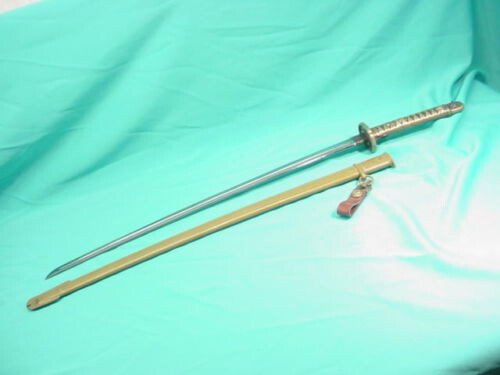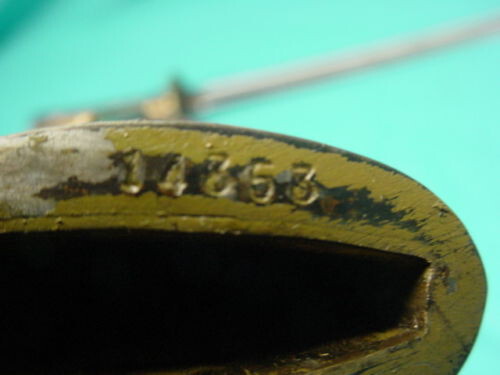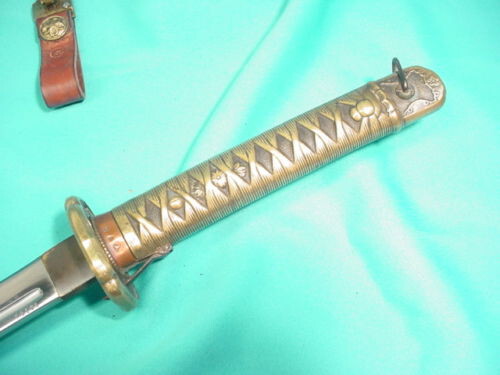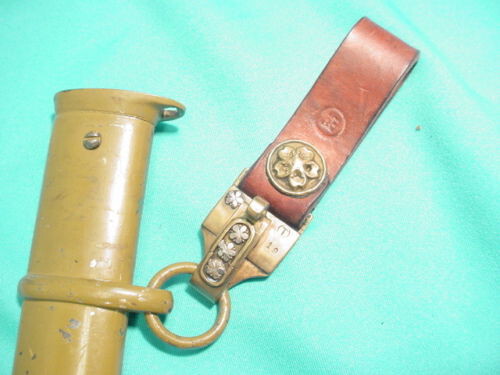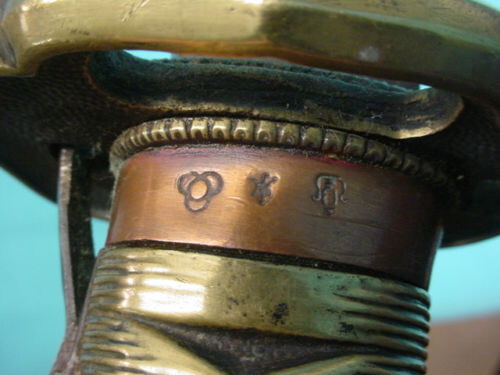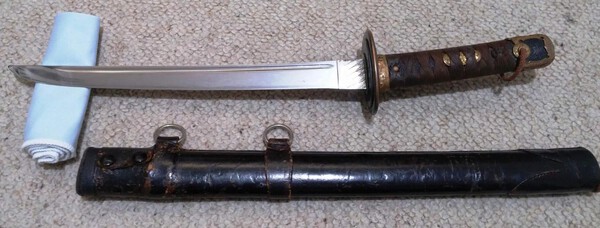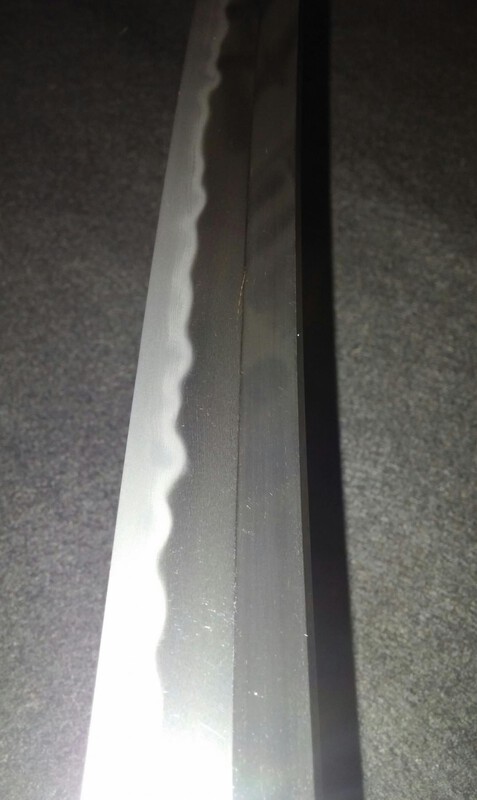-
Posts
1,402 -
Joined
-
Last visited
-
Days Won
12
Content Type
Profiles
Forums
Events
Store
Downloads
Gallery
Everything posted by Shamsy
-
I could be mistaking it with another book I've read. I'll have a look tonight and see where it was mentioned.
-
Hi Chris, All good suggestions. I can offer a far less practical one I'm afraid, but I believe if memory serves the book The Yasukuni Swords: Rare Weapons of Japan has a reasonable amount of information on the institute.
-
All correct! There are a bunch more issues with the sword, so if anyone wants to test their detective skills this is a good opportunity. I just wanted to chime in here... I probably say this way too much BUT to flog a dead horse, the NCOs have a ton of small variations between subcontractors and between batches themselves, so just something to keep in mind.
-
Hi all, A new sword was pointed out to me recently which is very well made and in fact at first glance addresses a lot of the issues with obvious fakes. Cheers to Dan for bringing it to my attention. Because it's really quite a nice repro, thought I'd better share it here as for reference. Obvious two issues are the scabbard pattern and additional screw. See how many more you can pick! Gee they're starting to get good though...
-
No worries and no need to apologise, I don't think anyone felt offended by this topic. We're here because we want to teach, share and learn a subject we love; Japanese swords. We won't always agree and we won't always be right and that's the nature of forums.
-
Each to their own Chris, I in no way take this personally The ‘Type 3’ will unfortunately be around for a long time, since there are no new books or articles emerging other than by Nick. So new collectors will continue to designate a type based off the incorrect year of acceptance (not that it is even a distinct pattern but anyway), because that is what they read in a book. I'll continue to call it a Type 0 now that the acceptance date has been discovered. Bruce was spot on and I mention it earlier; Rinji is already associated with a great group of unpatterned swords so we need something to call this pattern, for the sake of collectors. I would not call cars Ford, BMW, Porsche and blue one, so I will continue to use the correct name based on our type system which uses dates of acceptance.
-
Well said Dave. Nick in fact stresses that these are quality swords, just artificially priced. Sadly this thread seems to have now taken a turn from educational. I've nothing much to add. Looking forward to seeing some primary sources quoted though.
-
You're very welcome. It's not only very interesting from the perspective of the Type 0 development, but it also touches on some other interesting events, like the Type 95 rental/purchase programme and the ‘bring your own samurai sword’ initiative.
-
Nick is a current researcher that reads and translates the Japanese National Archives. I'm a big fan because he deals in hard facts, not speculation and myths. He has disproven many longstanding myths and exposed ingrained inaccuracies in existing research. You may like to read this linked thread, which specifically deals with the Type 3 myth. It will clear up a lot of your questions and put you ahead of the average 'book expert'. I've learned a lot and we're lucky, because Nick not only spends many hours doing this for our benefit, but he openly publishes his work, provides proof in the form of copies of the documentation and is very willing to assist when approached. Enjoy. http://www.warrelics.eu/forum/Japanese-militaria/deflating-another-myth-type-3-army-officer-s-sword-expanded-version-584796/
-
The various ‘types’ of sword are all named from the years they were introduced. The so called ‘Type 3’ was a designation from Western collectors and is incorrect. While in the strictest sense this sword is not even a ‘type’ anything, if it is to be designated based on date it was approved to enter production, as in line with Type 95 and 98, it would be the Type 0. This is 1940 (Year Zero, 2600). Since it is convenient to give the sword a ‘type’ because ‘last ditch’ or ‘desperate situation’ (Rinji) is a term used by Western collectors for a number of questionable quality swords from 1945, I use a correct designation in line with conventional naming. Again, full credit to Nick for the research, I am providing only the condensed version.
-
While the Type 0 was a last ditch sword, meant to speed production and minimise the use of essential war materials, it was fully intended to be a quality, practical and robust sword. So they are not necessarily inferior blades, merely priced artificially low by the army and navy. Straight out of Nick ' own words; "And like Type 98s there naturally would be luxury versions and barebones versions even for a sword conceived as a poor man's version. There will also be older blades made into the 1940 style, as the Appraisal Committee was sponsored directly by the army and navy. Also the scoundrels, who exploited the earlier shortage to peddle substandard quality swords, ripping off officers would have now tried to make money selling upgrade aftermarket kits, etc, etc. Officer items were private purchase items, and though they may have had difficulty buying one without having to pay an arm and leg for it, once they got one they could dress it up as they liked. So the existence of high quality examples of the 1940 model is totally natural and in no way conflicts with the account I have given you." So basically the Type 0 koshirae was an upgrade to the sword, exactly as the Type 98. There is no mystery in this. Possibly some officers believed the koshirae was more robust too.
-
Since Type 0 were contracted by the army, whereas the Type 98 were private purchases, the mounts were determined by who the customer was.
-
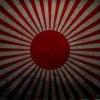
Would Appreciate Id Help W/ Wwii Japanese Short Sword.
Shamsy replied to CBurns's topic in Military Swords of Japan
A rag of raw cotton and half decent gun oil, or sewing machine oil both work well. I am not in favour of it, but some people are happy to use a more abrasive method to remove rust (only on machine made blades I'll add). -
After Neil has selected a book, I actually wouldn't mind a copy myself, so if anyone still has one, PM me.
-

Would Appreciate Id Help W/ Wwii Japanese Short Sword.
Shamsy replied to CBurns's topic in Military Swords of Japan
Yeah, afraid that looks exactly like the mass produced blades common to these swords. It's a little rough from the pictures but could probably clean it up with a little elbow grease. -

Omg Australian Fuc#### Customs Strike Again
Shamsy replied to lonely panet's topic in General Nihonto Related Discussion
I actually have the same experience. I've never had a sword stopped for anything other than the GST (such a pain, I don't care about paying it, but I am impatient to receive my parcel! Why can't they have a better system). I even had one arrive last week with a little note tucked inside saying 'opened by customs'. But swords are unrestricted imports (minus double edged). I've had them described as everything under the sun, and the only ones that get opened are the ones where the seller has been very vague (old bayo, decorative metalwork, wall hanger). I have more difficulty sending the OUT of the country. Sent one back to the U.S. and Aus Post asked if it was okay to send to states. I said that since you can mail-order firearms (black powder at least) I thought it would be okay. But even then there was no serious question of it being sent back. I've been asked if it's sharp and subsequently mentioned it is sheathed, which ends that line of questioning. I actually have found Aus Post and Border Force to be both reasonably helpful and efficient. For the most part they know the laws and apply them correctly. Your experience is unfortunate and I hope isolated. I hate FedEx - Overpriced and they WILL tear apart a parcel without care, question everything you tell them and conduct a FBI style interrogation, full of passive aggressive assertions from idiots that don't know the point of the sword from a handle. -

Would Appreciate Id Help W/ Wwii Japanese Short Sword.
Shamsy replied to CBurns's topic in Military Swords of Japan
Hi Cyn, No surprises here, the badge on the rear of the backstrap is the police badge. Can't really tell if the blade is mass produced. High chances yes. Could you provide a photo of the blade tip please. -
Hey Neil, found one, but it's a question of how much are you prepared to spend I'm afraid. Edit: Sorry, might be wrong on that count. Will keep an eye out.
-
Standard fake, mildly better than usual. Get some books back to read and compare or have a look through the numerous online resources. There's a ton of tell tale signs on these. It's an enjoyable exercise and useful. Feels pretty good when you begin to pick them. Edit: The only really good fakes are the Polish reproduction swords that are dolled up to become fakes. These have a number of warning signs too, but no one can be to blame for buying these, as they really are very faithful reproduction. Hats off to the Polish. These are the only ones I'd consider buying and only so I could swing it at a reed mat... because I'd like to see/feel how effective they were as functional weapons, plus the bonus of being able to wear it at military fairs without any concern for sweaty hands or knocks.
-
There is. There is one known example I've not seen, but one of the board members told me about. He has a picture too... Which I'll hassle him about finding again. So not really short, but this was a miniature version of an NCO. I can't remember much more, so I'll wait to get the facts before spreading possibly incorrect information. But in a more general sense, NCO are a standardised sword made by machine to specifications. They were also military (well the emperor's) property, not personally purchased (though officers could both rent an NCO and privately purchase them, but that's a whole new topic and not my work to claim). Anyway, ultimately I'm only trying to pass on the little I know, which I've learnt from much more studious types, so whether or not anyone listens is up to each individual. The Japanese national archives clearly discuss in great deal sword shortages and I can see no logical reason to refute the official documents.
-
I'll try to succinctly conclude; Shortage of available swords and lax regulation just about sum it up for the most part. I'm sure there are a number of other factors too; family blades, shorter stature, desire for quality that was not available in a longer blade, just person preferences, weight reduction and yes, possible space restrictions for vehicle crew... The conjecture on this is endless. What we know as fact though; there were severe sword shortages which on several occasions resulted in older wakizashi and katana blades being purchased/allowed to be mounted for officers. And as I mentioned, for a private purchase item with lax regulation, you can expect wakizashi to be present.
-
Thank you Ian. My personal bugbear is the way merchants pretend all NCOs are fake but the 3 pieces of junk they hold are real, so don't trust anyone else!! But I've been finding this crew gunto craze starting to concern me. The more people believe something the harder it is to obtain objective facts. Yoshisuke made this ko-wakizashi Measurements are roughly; Nagasa - 32cm Kasane - munemachi - 9mm - sakikasane - 4mm Mihaba - motohaba - 3cm - sakihaba - 2cm This is closer to what has been labeled 'crew gunto'. Personally I would elect to abandon this term all together as it is grossly misleading. It is basically the assigning a role to a weapon with zero proof as it its intended and actual role. Like calling all katana samurai swords, which they most certainly aren't. This debate will go the same way as the SNLF/Type 3 sword (when in fact no such pattern existed). It was merely an emergency pattern that at best can be called the Type 0. But sometimes things are too ingrained in a collecting society to change, despite new information disproving the old.
-

Nice Rare 1875 Field Officer Kyu-Gunto
Shamsy replied to Bochavista's topic in Military Swords of Japan
Very welcome Chris. These swords are not my interest, but the sword appears to be a scarce 1875 pattern Army Field Officer Kyu-Gunto Sword would have been carried by Major, Lt-Colonel and Colonel. So quite high up! That's probably a 'practical' blade too, looks to have a hamon. May be traditionally made or old family blade but I really can't tell from photos. Did it end up being sharp Chris? Yep, he won at an auction Bruce, at a very good price I might add. One of those rare bargains. -

Id Of Swords From The Korean/Japanese War And Ww11.
Shamsy replied to irocz86's topic in Military Swords of Japan
Or varnish perhaps Bruce? I have a Yasumitsu that was completely covered in varnish after the war to preserve it. It looked very much like this. -
Sorry Jojo, we are digressing off topic, but I was struggling to hold my peace on the whole crew gunto thing. I've been able to photograph all but one hamon by sitting in a dark room, back to a slightly opened window (just enough for an aura) and using a flash camera down the length of the blade. You should try that. Sadly acid or cleaning agents are applied by people, not time. Still a nice little wak though.



